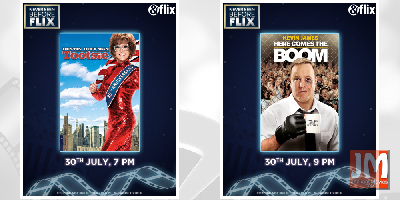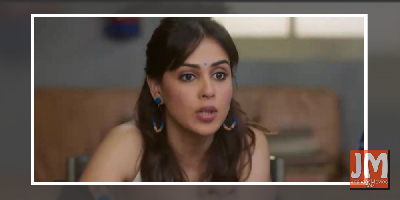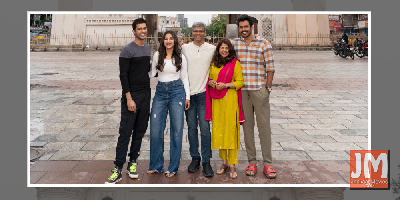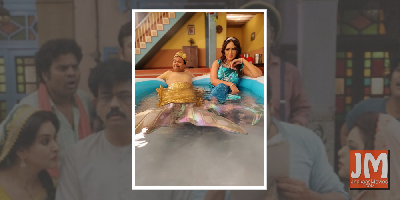 Aan Tiwari honoured with Best Child Actor award for Baal Shiv
Aan Tiwari honoured with Best Child Actor award for Baal Shiv Ghategi rahasymayi ghatnaye!
Ghategi rahasymayi ghatnaye! Amazon Prime Video unveils the 2021 Festive Line-up; brings a heady mix of Indian and International titles on the service
Amazon Prime Video unveils the 2021 Festive Line-up; brings a heady mix of Indian and International titles on the service Release: Music video of, Yeh Haalaath, from Mumbai Diaries 26-11
Release: Music video of, Yeh Haalaath, from Mumbai Diaries 26-11 Bhumi Pednekar feels she shares feel-good value with Akshay Kumar on screen
Bhumi Pednekar feels she shares feel-good value with Akshay Kumar on screen
The Men Behind Those Wall Posters

From the feedback I received on the article "That Thrill Of Film Posters On Walls" (IANS; 15.3.2020), some felt there was scope to be more elaborate about the whole process till these posters reached the walls. For the older generation it is nostalgia, but the present generation may find it strange that the entire long process involving many stages was done manually. Especially, to those whose creativity depends heavily on computer.
The designers of yore needed both imagination and talent. On computer, very little of both is required. Most of the inspiration or creativity, if you like to call it that, comes from foreign film designs or colourful books on designing. A computer hands you the designing tool at a click of a mouse.
If you look at the social media and memes posted there, you would think there is a designer in every person! The computers have made things that easy!
To cite a living example, the film publicity designing studio that has been ruling the roost for the last 20 years or so could do it only because of computers. Before computer designing arrived, this studio had probably nobody capable of drawing a straight line on the paper. In fact, this very studio outsourced designing to the very popular designing studio, Studio Link, where work was done manually! With the arrival of computer designing, they became wizards, dominating the field.
In the film industry, the watchword is "bhed chaal". If one wellknown producer opts for somebody, others follow. Studio Link, the most sought-after designing studio was soon forgotten. As it were, in those days, the word computer spelt magic for not so well-versed film folk.
Every producer had his favourite designer and, since there was stiff competition among this breed, each tried to keep ahead of the other, which showed on the ultimate outcome. There were big-name studios run by C. Mohan, Diwakar, Pamart, Boskey Prabhu, AAA Studios, SM Pandit, Artview, Studio Chandrakant, Ajanta Arts, SC Shrivastava, Ram Kumar, Samarth Art, when also came along JP Singhal, followed by C. Mohan's two former pupils, Atmanand and Vivek, who started Studio Link.
When JP Singhal and Studio Link started off, designing was still manual, but when computer graphics came on the scene, both soon adapted themselves to the new way. That was along with a lot of others who would never have become publicity designers were it not for computers!
Earlier, the first step in publicity designing started with the filmmaker showing his yet-to-release film to the designer. He would then select the shooting stills from the album that had the record of entire shooting of the film. Having seen the film, the designer knew the film's selling point, the USP. Miniature layouts were designed and given for approval to the filmmaker as well as the director, not to forget the star of the film who had the final say! A lot of money as well as careers were at stake besides the ego of the star, who always sought to be prominent in the display.
The designer's job was not limited to designing posters. He also had to prepare designs for the various poster dimensions, but also to prepare layouts for banners that not only adorned the street hoardings, which were a major medium of publicity, but also hundreds of cinema halls across the circuit where the film would be screened. For the distributors other than Bombay Circuit, miniature layouts were dispatched so that the distributor could get them painted according to the needs of the cinema halls.
The banners were handpainted on cloth in this well-coordinated system and the publicity looked uniform all over the country. Handpainting this cloth banners needed a lot of time and huge studio spaces that, in today's time, would cost crores. A designer, even if he owned such a studio space now, would have liquidated it and opted for a life of comfort. The payments in film business were never assured and getting dues was more laborious than designing and painting. To add to that, if a film flopped, like everybody else associated with it, the lot of designer also suffered, though he got no bonus if the film was a hit!
Things have changed now. The designing studios are not shown the film at all before its publicity material is prepared. Stakes are too high to do that. Earlier, a system was followed where just about everybody connected to a certain film was shown the film even when it was incomplete and that included the film's distributors from other circuits.
Gone are the wall posters and also gone are those handpainted cloth banners, and with it the fun of gazing at them.
@The Box Office
* The COVID-19 pandemic has led to closure of cinema halls, and wiped out box-office prospects of the two films already in the theatres -- "Baaghi 3" and "Angrezi Medium".
While "Baaghi 3" got exposure for a full week, "Angrezi Medium" suffered as the cinema closure was announced a day after it was released. While almost all the multiplex properties had announced shutdown, few stray halls that were still open gradually closed down one after the other.
* "Angrezi Medium" could collect about Rs 9 crore in the four days that cinema halls were functioning. The makers plan to re-release the film at a later date.
* "Baaghi 3" added about Rs 6 crore, taking its eight-day total to Rs 93 crore.








